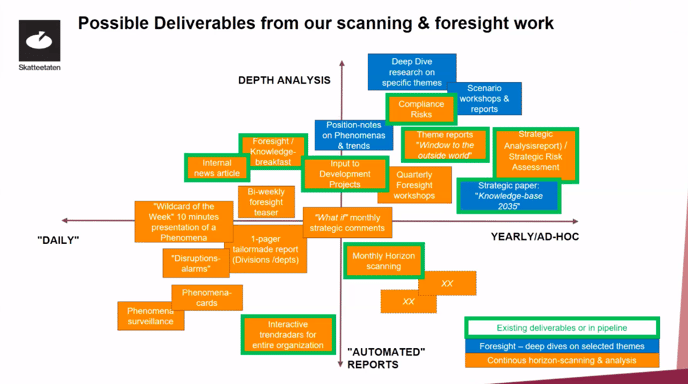In the 3rd Futures Clinic session, Futures Platform's Foresight Strategist Ira Stening discusses information deliverables of foresight work with a team of senior advisors from the Norwegian Tax Administration.
Speakers
- Ira Stening, Advisor, Foresight Strategist at Futures Platform
- Bente Groven Syversen, Senior Advisor at the Norwegian Tax Administration
- Erik Kaald Aaroee, Senior Advisor at the Norwegian Tax Administration
- Magne Vangen, Senior Advisor at the Norwegian Tax Administration
- Karin Trandheim Roen, Senior Advisor at the Norwegian Tax Administration
- Gunnar Sjoewall, Senior Advisor at the Norwegian Tax Administration
Executive Summary
3Cs of Foresight Deliverables: Contextual, Continuous, Communicative
As the most tangible part of the larger foresight process, foresight deliverables promote awareness of the possible futures to larger audiences and support collaboration. According to Foresight Strategist Ira Stening, there are three key elements to the effective delivery of foresight results - context, continuity and communicativeness.
First and foremost, foresight deliverables should be contextual, meaning that they tie into organisational plans and strategies. Alternatively, they may also investigate a particular uncertainty that plays a key role in the organisation’s future operating environment.
Secondly, foresight deliverables should be continuous. As the future is continuously in flux, foresight deliverables should likewise offer a steady flow of information on future changes. While the ideal frequency may differ based on organisational contexts and needs, what is important is that foresight deliverables are not a one-off effort.
For foresight deliverables to make an impact, they also need to be communicated in an engaging way. Depending on the context and the audience, findings of the foresight work can be delivered in the form of short videos, reports, scenarios, workshops, events and more.
Norwegian Tax Administration’s approach to foresight deliverables
When the Norwegian Tax Administration first set out to design a process for foresight deliverables, they found manual signal collection time-consuming and rather inefficient. To help them manage the information overload and partly automate the horizon scanning process, the team started using Futures Platform.
Today, Futures Platform’s digital foresight service supports the team’s foresight efforts as a base for surveillance, categorisation, visualisation and further collective exploration of future changes.
.png?width=688&name=Frame%201%20(4).png)
Image Credit: Skatteetaten, the Norwegian Tax Administration
As the Norwegian Tax Administration has a diverse group of stakeholders, their foresight deliverables also vary in format and frequency, says senior advisor Erik Kaald Aarøe. They produce a wide set of deliverables ranging from broader cross-industry horizon scanning to more in-depth analyses of selected themes. The frequency likewise varies from yearly reports to ad—hoc analyses and daily updates.

Image Credit: Skatteetaten, the Norwegian Tax Administration
Intranet: A Living Foresight Deliverable
Since traditional static documentation can quickly become outdated, the Norwegian Tax Administration’s Intranet is a dynamic solution that enables continuous updating of the organisation’s foresight deliverables. It is an internal network accessible to all employees and stakeholders, allowing the organisation to reach all of their target groups in one place.
As a living deliverable, the Intranet utilises different content forms to communicate future changes, such as articles, reports and videos. The published material can be regularly updated to reflect on the latest developments. Contributors to the platform come from different divisions of the organisation to ensure a wide variety of perspectives on future changes and phenomena.
The Norwegian Tax Administration’s Intranet utilises Futures Platform’s content database as a basis. The relevant trends are first identified on Futures Platform and then customised to the organisation’s operational context. This allows the participants to collectively assess possible implications from the organisation’s point of view.
In the near future, the team also plans to embed Futures Platform’s interactive foresight radars into the organisation’s Intranet to make their deliverables more engaging and collaborative.
